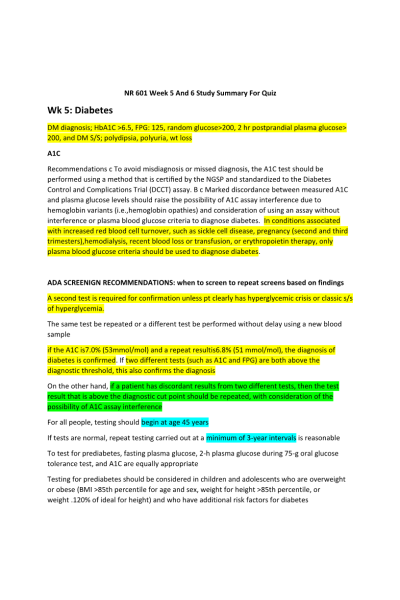Week 5: Diabetes
DM diagnosis; HbA1C >6.5, FPG: 125, random glucose>200, 2 hr postprandial plasma glucose> 200, and DM S/S; polydipsia, polyuria, wt loss
A1C
Recommendations c To avoid misdiagnosis or missed diagnosis, the A1C test should be performed using a method that is certified by the NGSP and standardized to the Diabetes Control and Complications Trial (DCCT) assay. B c Marked discordance between measured A1C and plasma glucose levels should raise the possibility of A1C assay interference due to hemoglobin variants (i.e.,hemoglobin opathies) and consideration of using an assay without interference or plasma blood glucose criteria to diagnose diabetes. In conditions associated with increased red blood cell turnover, such as sickle cell disease, pregnancy (second and third trimesters),hemodialysis, recent blood loss or transfusion, or erythropoietin therapy, only plasma blood glucose criteria should be used to diagnose diabetes.
ADA SCREENIGN RECOMMENDATIONS: when to screen to repeat screens based on findings
A second test is required for confirmation unless pt clearly has hyperglycemic crisis or classic s/s of hyperglycemia.
The same test be repeated or a different test be performed without delay using a new blood sample
if the A1C is7.0% (53mmol/mol) and a repeat resultis6.8% (51 mmol/mol), the diagnosis of diabetes is confirmed. If two different tests (such as A1C and FPG) are both above the diagnostic threshold, this also confirms the diagnosis
On the other hand, if a patient has discordant results from two different tests, then the test result that is above the diagnostic cut point should be repeated, with consideration of the possibility of A1C assay interference
| Instituition / Term | |
| Term | Summer 2020 |
| Institution | Chamberlain |
| Contributor | Chantara |


























































